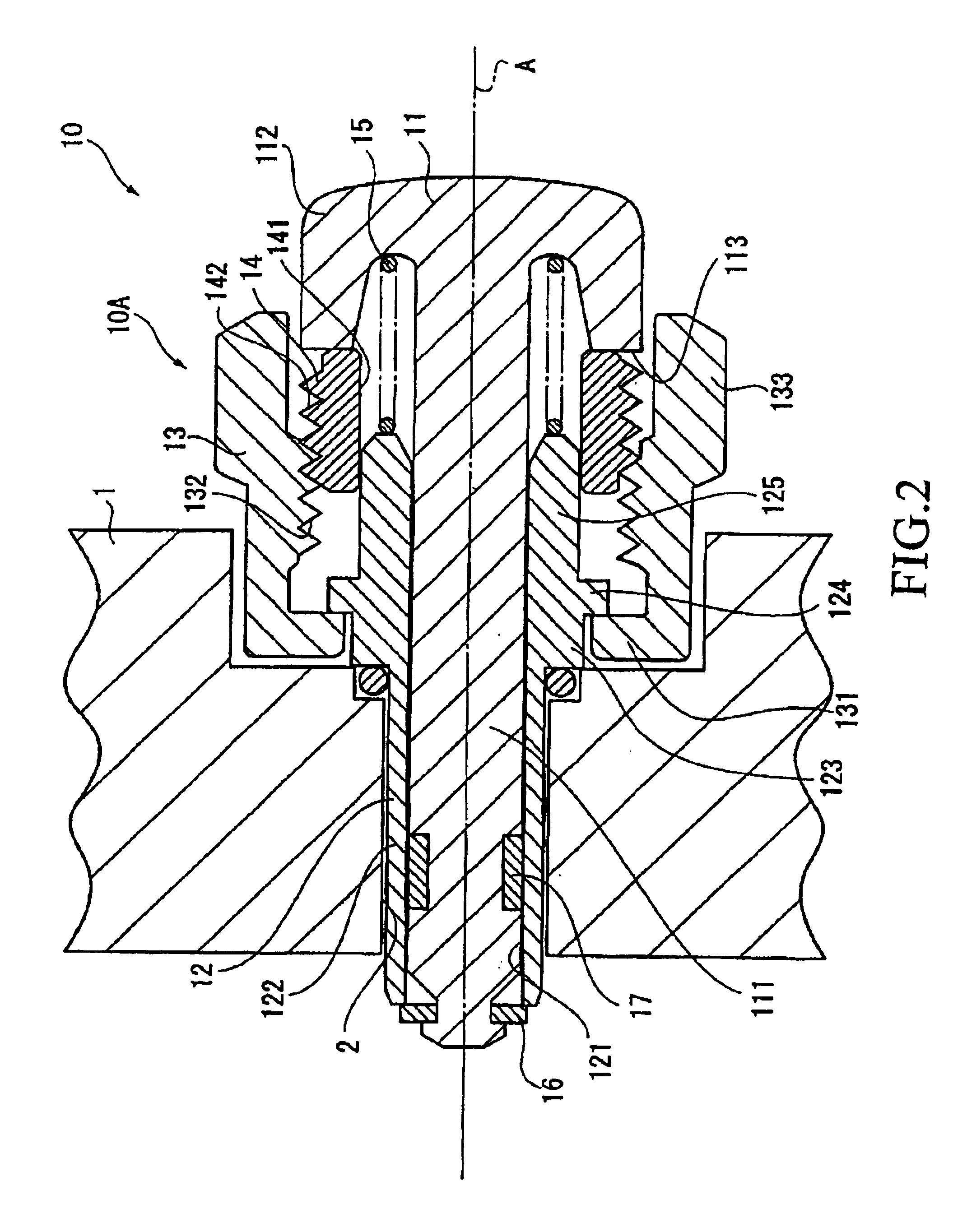Lockable pushbutton actuator for a display device such as a watch
- Summary
- Abstract
- Description
- Claims
- Application Information
AI Technical Summary
Benefits of technology
Problems solved by technology
Method used
Image
Examples
first embodiment
(First Embodiment)
The button structure related to the first embodiment of the present invention is described below based on FIGS. 1 to 4.
The button structure of the present embodiment is one of an operating button 10 disposed on a external surface of a main body of a wristwatch, pocket watch, or other portable watch; or a stopwatch, dive computer, or other type of portable equipment.
FIGS. 1 and 2 show the operating button 10 and are cross-sectional views that illustrate the unlocked and locked states, respectively. FIG. 3 is an exploded perspective view of the operating button 10. FIG. 4 is a side view showing the essential portions of the operating button 10, and is a side view of a hereinafter-described fixed member 12.
In FIGS. 1 to 4, a case 1 serving as the casing forms the external shell of portable equipment (the main body of the portable equipment), and houses drive mechanisms, power sources, computing units, display units, and other components (not depicted). The operating b...
second embodiment
(Second Embodiment)
Next, the button structure related to the second embodiment of the present invention is described based on FIGS. 5 to 7.
The button structure of the present invention has substantially the same configuration as the operating button 10 in the above-described first embodiment, but differs in that the shape of the lock member 14 is different and a restricting member is provided. These differences are described in detail below.
FIG. 5 is a cross-sectional view showing the operating button 10 of the present embodiment, the area above the axial center A shows a locked state, and the area below the axial center A shows an unlocked state.
In FIG. 5, the lock member 14 protrudes toward the head portion 112 of the button member 11, and has a locked state indicator 145 formed in the shape of a ring about axial center A. When locked, a locked state indicator 145 protrudes by an amount equal to the dimension x away (right side of the diagram) from the gap between the head portion...
third embodiment
(Third Embodiment)
Next, the button structure related to the third embodiment of the present invention is described based on FIGS. 8 and 9.
The button structure of the present invention has substantially the same configuration as the operating button 10 in the above-described first embodiment, but differs in terms of the threading and connecting relationships of the fixed member 12, the ring member 13, and the lock member 14. These differences are described in detail below.
FIGS. 8 and 9 are-cross-sectional views showing the operating button 10 and the unlocked and locked states, respectively.
In FIGS. 8 and 9, a guide portion 125 of the fixed member 12 is formed into a shape whose cross section is substantially cylindrical, and a threaded portion 126 that threadably engages the internal peripheral surface of the lock member 14 is formed on the external peripheral surface of the guide portion 125. A guide groove 134 that slidably engages the external peripheral surface of the lock membe...
PUM
 Login to View More
Login to View More Abstract
Description
Claims
Application Information
 Login to View More
Login to View More - R&D
- Intellectual Property
- Life Sciences
- Materials
- Tech Scout
- Unparalleled Data Quality
- Higher Quality Content
- 60% Fewer Hallucinations
Browse by: Latest US Patents, China's latest patents, Technical Efficacy Thesaurus, Application Domain, Technology Topic, Popular Technical Reports.
© 2025 PatSnap. All rights reserved.Legal|Privacy policy|Modern Slavery Act Transparency Statement|Sitemap|About US| Contact US: help@patsnap.com



